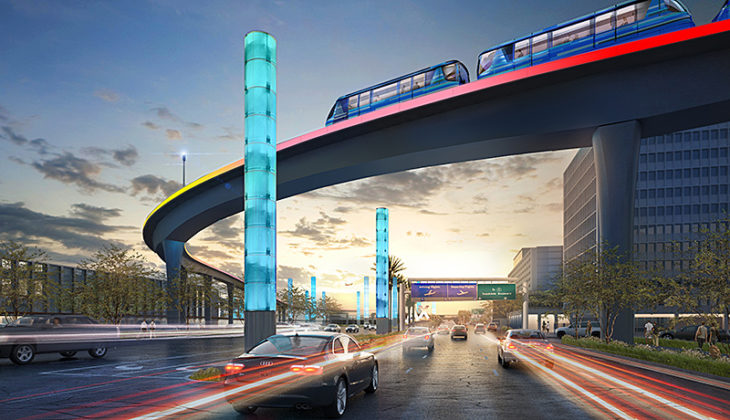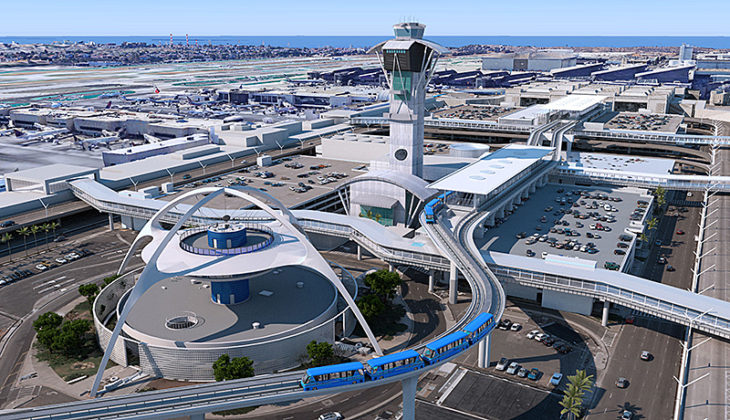Many airports have automated trains that connect passengers between terminals. Two prime examples in the NYC area are the AirTrain at John. F. Kennedy International Airport and the AirTrain at Newark Liberty International Airport.
For those at Los Angeles International Airport, good news as the airport commission approved a $5 billion contract to build an automated people mover to connect passengers between terminals. The next step is a vote from the city council, which should pass with a goal to have this fully built and operational by 2022 with plans to carry 85 million passengers annually.

Per LAWA,
The Automated People Mover (APM) is an electric train system on a 2.25 mile elevated guideway with six stations total – three outside the terminal loop and three inside.Â
LAX anticipates groundbreaking in 2018 and the APM to be fully operational in 2023. Pre-construction activities—such as utility relocations, geotechnical investigations and surveying—will begin in the second quarter of 2018. Construction of the guideway—the elevated track along which the APM will run—will start in Summer-Fall 2019. Late 2019 will see construction begin on the six stations. The first APM car will be delivered in late 2020. Major construction will be complete in mid-2022, at which point extensive testing will begin for several months. The APM will be open for passenger services in early 2023.
The APM will have nine trains, each with four cars. Each car will carry up to 50 passengers and their luggage, with a total of 200 per train. Train speed will top out at 47 mph. Trains will be available at each station every two minutes with a total of 10 minutes travel time end-to-end. For easy access, the APM trains will have large, wide doors and each car will have 12 seats designated for travelers in need. The APM will be FREE for all users and operate at all times. Anticipated use will be 30 million passengers per year.



$5 billion???? Whose money are they spending?
LAX is not that big. There is not much traffic between terminals except maybe at the TBIT (international terminal). Walking is not that far.
So they are spending $5 billion for a rental car train? That is maybe the cost of 50,000 Hertz buses. If you bought one bus a year, that is 50,000 years.
Derek, the $5B cost is split between the airlines and rental car companies through rental rates and fees (this is where part of the CFC and PFC goes). This is a landside train,so it’s less about connections between terminals and more about getting people into the airport to begin with. The central terminal area loop is insanely congested for large parts of the day so this will do a few things. First, all buses for hotels and rental cars will no longer pick up curbside but instead at the new intermodal transportation facility and I read that they may push all Lyft and Uber’s out there too. It will also connect with the Metro system so maybe ppl will start using it to get to LAX. Either way, it’s a lot more than just a rental car train.
@ Derek, yeah, read about what it covers. Not just for rental cars. If I could get to LAX on public transport easy like I can to JFK/SFO/EWR or god forbid we bring up LHR/FRA and much of Europe who make actual easy transport that avoids traffic. Traffic can be horrendous sometimes. So this will be a boon for the airport to limit cabs and ride shares and rental car busses to outside the airport.
Even if it were municipal money, the price tag doesn’t mean its wasteful. If it has a benefit and has a source of revenue (airport fees), it helps the economy, keeps the airport functioning better and maybe, just maybe, moves us towards another airport that has more than just a cab or a car to get to as an option. Infrastructure at Airports is probably one of the best uses of public money as they have a way to recoup their investments.
Anyone who has been to LAX knows that it is necessary. But $5 Billion. That is insanely inflated to account for the craziness of California.